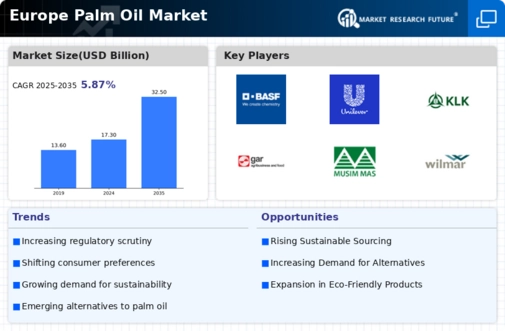The Europe Palm Oil Market is characterized by a complex, competitive landscape driven by evolving consumer preferences, regulatory frameworks, and sustainability concerns. As the demand for palm oil continues to rise across various sectors, including food, cosmetics, and biofuels, companies are finding innovative ways to enhance their market position. Sustainability remains a significant topic, and many organizations are focusing on responsible sourcing, certification, and transparency in their supply chains in response to consumer scrutiny.
Additionally, the competitive dynamics are influenced by regional policies, international trade agreements, and the activities of both small and large players who aim to capture market share. The competition is not only about price but also about offering sustainable and high-quality products that align with the growing demand for environmentally responsible solutions in the European market. BASF has established itself as a formidable player in the European palm Oil Market, leveraging its substantial technological expertise and commitment to sustainability.
The company's focus on innovative agricultural solutions allows it to provide a variety of palm oil-derived products, catering to industries ranging from food and nutrition to personal care and industrial applications. BASF's strengths lie in its robust research and development capabilities, enabling it to create sustainable formulations that meet the demanding standards of European consumers. Furthermore, its strategic collaborations and partnerships within the palm oil supply chain enhance its market presence and operational efficiency, allowing it to cater effectively to evolving customer needs while minimizing environmental impact.
BASF's strong brand recognition and reputation for quality bolster its competitive positioning within the region.Austrian Palm Oil is another significant entity within the European palm Oil Market, known for its engagement in sourcing and trading palm oil products. The company offers a range of products, including refined palm oil, palm kernel oil, and various derivatives that are widely used in food production, cosmetics, and personal care sectors. Austrian Palm Oil has carved out a niche by focusing on both quality and sustainability, ensuring compliance with stringent European regulations.
Its market presence is strengthened through key partnerships and collaborations aimed at responsible sourcing practices. The company prides itself on its transparent supply chains and commitment to sustainability, which resonate well with the conscious consumer base in Europe. Additionally, Austrian Palm Oil has engaged in strategic mergers and acquisitions to bolster its offerings and expand its presence in the regional market. These strengths position Austrian Palm Oil as a reliable provider, catering to the increasing demand for sustainably sourced palm oil among European consumers.



















Leave a Comment